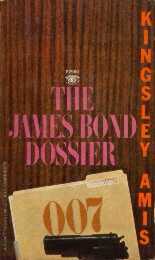
 |
Amis, Kingsley, THE JAMES BOND DOSSIER, 2, 1966, Signet, PB. The first, and in many ways, the best of the "fictional biographies" of James Bond, by a major British novelist who later wrote a his own Bond novel COLONEL SUN (see Markham, 1968 entry). |
Anonymous, MY SECRET LIFE, 1, 1966, Grove Press, HB. Two Volumes.
AVENGERS. THE, T. V. Show, 1966. First U.S. episode 29 Mar. 1966.
 |
BARBARELLA, Collected Comic Strip, 2, 1966, Grove Press, HB. Writer/ Illustrator: Jean Claude Forest. The true father of the comic "graphic novel." |
 |
Burroughs, William S. NAKED LUNCH, 2, 1966, Grove Pres, PB. |
Burroughs, William S., THE SOFT MACHINE, 1, 1966, Grove Press, HB. Originally
pbublished by Olympia Press, Paris, in 1961. See 1967 entry.
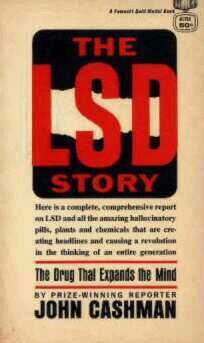 |
Cashman, John, THE LSD STORY, 1966, Fawcett. PB. LSD was a big story in 1966, and a lot of books came out about it. This one is an original quicky put out for Fawcett's Gold Medel line. If you couldn't reprint a good book on LSD, you hired someone to write one for you ASAP! |
Charroux, Robert (Robert Grugeau), TREASURES OF THE WORLD, 1966, P. S. Erikson, HB. Need Copy and info. PB?
Cohen, Leonard, BEAUTIFUL LOSERS, 1, 1966, Viking, HB. See 1967 entry.
DARK SHADOWS, T. V. Soap Opera, 1, 1966, ABC-TV. Curtis. Producer: Dan. This was a popular daytime soap opera that dealt with the events in a family whose members included vampires, werewolves, and practitioners of all sorts of magic. The show seems to have sparked interest in occultism and magic, especially among young female viewers. It developed a cult following that remains strong, even in the sleazy 80's. There was a series of paperback tie-in novels which were also quite popular. The success of the show brought Dan Curtis into prominence, allowing him to bring horror and supernatural shows and T. V. movies into prime time (see NIGHT STALKER, 1972 entry).
Deacon, Richard (Donald McCormick), MADOC AND THE DISCOVERY OF AMERICA,
1966, George Braziller, HB, Entry
 |
Edwards, Frank, FLYING SAUCERS -- SERIOUS BUSINESS, 1,
1966, Lyle Stuart, HB. See 2nd entry
Edwards, Frank, FLYING SAUCERS--SERIOUS BUSINESS, 2, 1966, Bantam, PB. entry. |
EYE OF THE DEVIL, Motion Picture, 1966, Thompson. Director: J. Lee,
Based on DAY OF THE ARROW by Philip Loraine, Also released with the title
13. David Niven plays a Count who is destined to be sacrificedby a coven
of fertility worshipers if the grape crop fails. The plot comes straight
from Margaret Murray's theories of witchcraft as the "old religion." The
technical advisor for this film was Alex Sanders, one of the major forces
in British witchcraft. Sanders claimed to have initiated Sharon Tate, who
played the local witch/bitch in the film, into his craft (actually Sanders
and Tate may have met earlier on some Hammer film projects). You can just
imagine the kind of rumors that this generated after Tate was slaughtered
by the Manson cult. The movie is rather boring despite all that technical
advice.
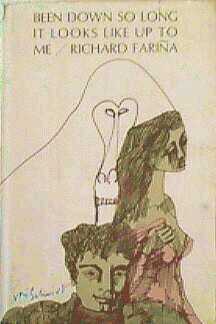 |
Farina, Richard, BEEN DOWN SO LONG IT LOOKS LIKE UP TO ME, 1, 1966, Random House, HB. This is a classic of late 50's, early 60's "bohemian" culture. Farina, sadly, is best known today because he was a close friend of Thomas Pynchon (GRAVITY'S RAINBOW is dedicated to him). In the 60's Farina was a well known musician, and one of the guiding lights of the "folk rock" scene. Farina died in a freak accident, while on the way home from the party celebrating the publication of this title. It is hard to judge what his literary impact would have been had he produced more than this novel, and a few other short pieces. Farina's style is very similar to Pynchon's. The novel is a good look at attitudes and values within the Eastern "bohemian" scene. I recall a lot of early "heads" trying out paragoric loaded Pall Mall's after reading this work. |
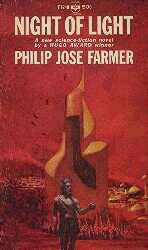 |
Farmer, Philip Jose, NIGHT OF LIGHT, 1966, Berkley, PB. This book is reputed to be the inspiration for Jimi Hendrix's rock anthem "Purple Haze." |
Fuller, John G., INTERRUPTED JOURNEY, THE, 1, 1966, Dial Press, HB. See 1974 entry.
Gazia, Alfred de, ed., VELIKOVSKY AFFAIR, THE, 1, 1966, University Books, HB. This is a spirited defense of Velikovsky by some of his supporters in scientific fields. It's also the best history of the events surrounding the attempt to suppress WORLDS IN COLLISION in 1950.
Gibson, Walter B. and, Gibson. Litzka R., COMPLETE ILLUSTRATED BOOK OF THE PSYCHIC SCIENCES, THE, 1, 1966, Doubleday, HB. See 1968 entry. Fans of old pulp literature will recognize Walter Gibson as the man who wrote THE SHADOW stories under the pseudonym of Maxwell Grant. Fans of stage magic know him as a practicing magician and author of many books on the subject. This book takes the practical approach to the unexplained. So you want to open your own fortune telling parlor, eh? Well, you'd do well to find a copy of this volume. It gets into the summary, does it impartially, and gets on with the next topic with hardly any occult rhetoric at all. This is one of the best fortune telling "cookbooks" ever written. Nowhere, however, does it tell how to "cloud the minds of men"--shucks (see also "Grand Orient" 1972 entry).
THE GOOD, THE BAD, AND THE UGLY, Motion Picture, 1, 1966, Director: Sergio Leone. Italian release date. This is the third film in Leone's classic series with Clint Eastwood (See 1967 entry).
Graves, Robert and Patai, Raphael. HEBREW MYTHS, 2, 1966, McGraw Hill,
Trade.
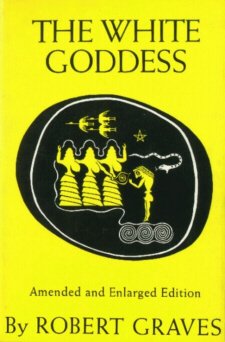 |
Graves, Robert, WHITE GODDESS, THE, 2, 1966, Farrar, Straus and Giroux, Trade. Amended and expanded edition. This is the third version of THE WHITE GODDESS to be presented to the public. The big difference between this version and earlier versions is the inclusion of information on psychedelic mushrooms developed by Graves and R.Gordon Wasson. Graves' subtitle is largely ignored: "A Historical Grammar of Poetic Myth". It was Graves' theory that most true poetry addresses the "muse," who is the great goddess of the pagan past. It is basically an aesthetic theory of poetry through historical arguments. The book has been used as a mythology text, a proof for the existence of the matriarchy, and a kind of "Bible" for neo-paganism, even though it was never intended to be used as such. THE WHITE GODDESS in this edition really came into its own in the 70's. |
Hall, Adam, QUILLER MEMORANDUM, THE, 2, 1966, Pyramid Books, PB.
Hapgood, Charles, MAPS OF THE ANCIENT SEA KINGS, 1, 1966, Chilton, HB.
Hapgood claimed that medieval navigation maps were copied from ancient
maps. These ancient maps appear to have used advanced cartographic methods
(like trigonometry) thought to be relatively modern inventions. These maps
also show the sea level where it was during the Ice Ages. Hapgood suggested
that these were the products of a seafaring culture operating at a time
when humans were thought to be painting themselves blue and howling at
the moon. This is one of those true "seed" books. It was Hapgood who pointed
out the amazing features of the Piri Re'is map. Erich von Daniken would
have been lost without it. For anyone who believed that ancient people
may have been more advanced than is generally accepted, this book is a
real gold mine. This remains, in my opinion, one of the best "fringe" books
ever published.
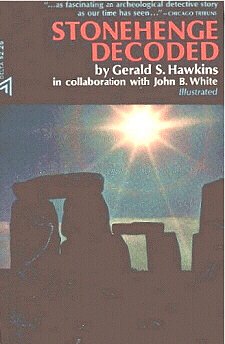 |
Hawkins, Gerald, with White, John B., STONEHENGE DECODED, 1965?, Delta (Dell), Trade. Most people read STONEHENGE DECODED in the Delta trade edition which, after many printings, had no original publication date. I would guess that 1966 would be right. |
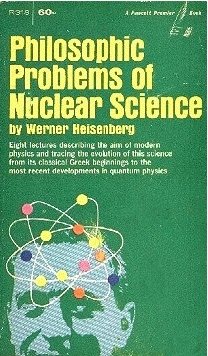 |
Heisenberg, Werner, PHILOSOPHICAL PROBLEMS OF NUCLEAR SCIENCE, 2, 1966, Fawcett, PB. |
Hesse, Hermann, DEMIAN, 1, 1966, Bantam, PB. Translation of 1919 German
Title. entry.
 |
Howard, Robert E., and Camp, L. Sprague de, CONAN THE ADVENTURER, 1966, Lancer Books, PB. Cover Art by Frank Frazetta. Listed as "Volume One of the Complete Conan". In chronological order, this is actually number five, as Ace later renumbered them. This is the first major mass paperback appearance of Howard's hero. It sparked the revival of the heroic fantasy genre, a product of WEIRD TALES and other pulps of the 30's. The genre had all but died out in the 50's. De Camp and executor Glen Lord picked the right time to revive the series. Howard was the Yang to Tolkien's Yin. Howard borrowed much of his "universe" from Mme. Blavatsky and theosophy, probably via his father's involvement in the "new thought" movement (see de Camp et.al., DARK VALLEY DESTINY, 1983 entry. It's possible that this may have helped rekindle interest in theosophy in the 60's. |
Laing, R. D., Phillipson, H. and Lee, A. R., INTERPERSONAL PERCEPTION, 1, 1966, Springer Publishing Co. (NYC), HB. See 1972 entry.
Lane, Mark, RUSH TO JUDGMENT, 1, 1966, Holt, Rinehart and Winston, HB. Mark Lane was hired to defend Lee Harvey Oswald. He was out of a job by the time he got his bags packed. Unable to defend him in court, he defended Oswald in print. The book is a frontal attack on THE WARREN REPORT (see 1964 entry). It's not the first book to raise questions about THE WARREN REPORT, but it was the first major work that was widely read. In some ways, it's still the best. Lane was a good defense attorney, a good writer, and one hell of a self-publicist. I was at one of his multi-media lectures in the early 70's, where he had the whole audience, disbelievers and all, ready to board the bus for D.C., to beat down their congressmens' doors to get them to reopen the case. For once, it worked-they did re-open it (but, see FINAL ASSASSINATIONS REPORT, 1979 entry).
Lawrence, Lincoln (Pseudonym), WERE WE CONTROLLED?, 1967, University Books, HB. The murder of President John F. Kennedy spawned a lot of really weird conspiracy theories. There was a whole underground of books, usually privately published, which presented a whole range of really bizarre, often truly paranoid, theories. This title is interesting because it was published by a commercial publisher. "Lawrence" is supposed to be a well known journalist, with wide sources in the US government. His thesis is that both Lee Harvey Oswald and Jack Ruby were victims of mind control (electronic controls implanted in their heads!), sent to do the bidding of an international conspiracy seeking to make a "killing" on the stock market. The book has all the earmarks of a hoax.
le Poer Trench, Barnsley (Earl of Clancarty), FLYING SAUCER STORY, THE, 1, 1966, Neville Spearman (London), HB.
le Poer Trench, Barnsley (Earl of Clancarty), FLYING SAUCER STORY, THE, 2, 1966, Ace, PB. Above date questionable.
Levin, Ira, ROSEMARY'S BABY, 1, 1966, Random House, HB. The occult thriller was almost dead as a fiction genre when this book came along. Levin's novel about a young woman chosen by a Satanic cult to bear the Devil's child, struck a chord and sold like crazy. It seems to have been the biggest hit with the female audience. There's little doubt that this novel rekindled interest in horror and occult thrillers. It is also logical to suspect that it may have added some fuel to the rising interest in the occult at that time.
Lorenzen, Coral E., FLYING SAUCERS, 2, 1966, Signet, PB. Reprint THE GREAT FLYING SAUCER HOAX (1962 entry).
Marcus, Steven, OTHER VICTORIANS, THE, 1, 1966, Basic Books, HB. See 1967 entry.
Masters, R.E.L., and Houston, J., VARIETIES OF PSYCHEDELIC EXPERIENCE,
1966, Holt, Rinehart, and Winston, HB. Another volume in the essential
psychedelic library. Like many others in the psychedelic field, Masters
and Houston drifted into "human potential" areas by the 70's.
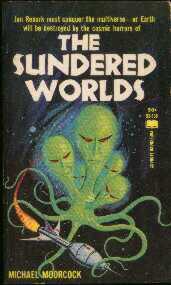 |
Moorcock, Michael. THE SUNDERED WORLDS, 1, 1966, Paperback Library, PB |
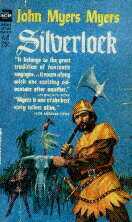 |
Myers, John Myers, SILVERLOCK, 2, 1966, Ace Books, PB. Reprint of 1949 title. A long needed revival of the influencial and important novel in the history of the modern fantasy. |
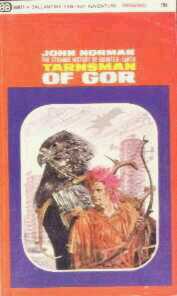 |
Norman, John [John Frederick Lange, Jr.], TARNSMAN OF GOR, 1, Ballantine Books, PB. "And that's Doctor John to you. slave!" The first of the seemingly endless Gor series. Actually, this novel showed some promise as a new take on some old fantasy themes . As it turned out it was only Edgar Rice Burroughs with bondage. |
Perry, John Weir, LORD OF THE FOUR QUARTERS, 1, 1966, Braziller, HB.See 1970 entry.
PHOEBE ZEIT-GEIST, Comic Strip, 1, 1966, Writer: Michael O'Donoghue.
Artist: Frank Springer, Featured in THE EVERGREEN REVIEW. PHOEBE ZEIT-GEIST,
which means "splendid spirit of the times," is actually the forerunner
of the NATIONAL LAMPOON/ SATURDAY NIGHT LIVE school of satire. Phoebe loses
her clothes in the first few pages and never regains them. She is the victim
of almost every indignity imaginable. At one point in the story she's killed
and the indignities continue anyway. Along the way O'Donoghue satirizes
just about anything you can think of--from the sexual underground, Zen
archery, Norman Mailer, TERRY AND THE PIRATES (which Springer had drawn
for a while), to, of course, sexy European comics like BARBARELLA. Phoebe
had a noticeable influence on the underground comic movement. O'Donoghue
was one of the founders of the NATIONAL LAMPOON, and he and Springer were
responsible for many of its comic parodies.
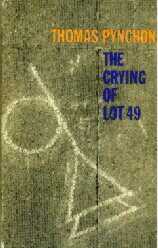 |
Pynchon, Thomas, THE CRYING OF LOT 49, 1, 1966, LIPPINCOTT, HB. W.A.S.T.E not, want not. |
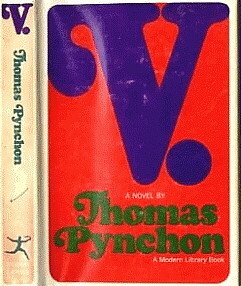 |
Pynchon, Thomas, V, 3, 1966, Modern Library, HB. This is essentially a vertual prepinting of the first edition. |
| Pynchon, Thomas, V, 4, 1966, Penguin Books, PB. First British pb edition. Wonderful pop art style cover by Tony Evans illustrates Benny Profane's mock heroic stalk of the mythic alligators in the sewers of New York. |
Queen, Ellery [Frederic Dunnay and Manfred B. Lee], A STUDY IN TERROR, 1, 1966, Lancer Books, PB. One of the most curious original paperback books ever published. Dispite some confusion concerning this book, it was released as a tie-in with the Sherlock Holmes movie of the same name released a year earlier (1965 entry). The International Movie DataBase for example, lists this book as the basis of the movie, which it is not. The author of the novel completely rejects the ending of the film and concocts a new new solution to the Jack the Ripper murders. The following year Lancer reprinted the book with no mention of the movie. There is still one more mystery concering the true authorship of this book (see 1967 entry).
Rand, Ayn, CAPITALISM: THE UNKNOWN IDEAL, 1, 1966, New American Library, HB. See 1967 entry.
Rohmer, Sax (Arthur Sarsfield Ward), BROOD OF WITCH, 1966, Pyramid, PB. Reprint of 1924 title.
Rohmer, Sax (Arthur Sarsfield Ward), QUEST OF THE SACRED SLIPPER, THE, 1966, PB. Reprint of 1919 title.
Schonfield, Hugh, PASSOVER PLOT, THE, 1, 1966, Bernard Geis, HB. Schonfield
had been a fairly quiet writer of general articles on biblical scholarship
until he wrote this one. His opinion: Jesus was the prime engineer of his
own crucifixion (for political reasons), and may have survived it all.
Shortly after publication, it really hit the fan. Orthodox theologists
wrote refutations. Fundamentalists and Catholic priests denounced it from
the pulpit. This guaranteed its resounding sales success. Schonfield is
probably the founding father of popular biblical revisionism.
 |
Solomon, David, LSD: THE CONSCIOUSNESS EXPANDING DRUG, 2, 1966, Berkley, PB. With a introduction by Tim Leary, and some articles by some of the heavy hitters in the realm of consciousness expansion. This is still a good book today, though a little dated, and was one of the essential volumes in the counterculture library. |
STAR TREK, T.V. Show, 1966, First Episode 8 Sept. 66. Remember when
the television season started in early September and ran more or less concurrent
with the school season? This legendary science fiction show is actually
WAGON TRAIN in outer space. There is enough written about this series to
fill a large house with paper. Just this: the next time you're watching
reruns or spending Friday night at the VCR, try to view it as a kind of
time machine to the mid-60's mindset. Roddenberry and Co. pulled a lot
from the common pool of ideas of the time. I notice now often Norbert Wiener's
(see below) ideas crept into the show's scripts.
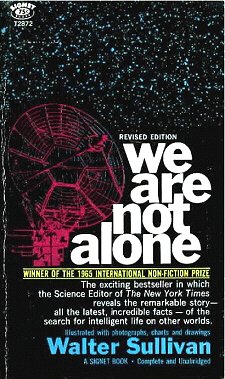 |
Sullivan, Walter, WE ARE NOT ALONE, 2, 1966, Signet, PB. This is a level headed look at the search for intelligent life in space. The information and technology is now out of date, but the arguments are not. This is a good place to get a feel for the real excitement there was for space exploration and research in the mid-60's. The book was written before the rise of Carl Sagan as science's media superstar, and spokesman for these projects. This makes it an important historical document. Sullivan's work is still invaluable in understanding much of our own expectations and dreams associated with the first phase of true space exploration. |
Vallee, Jacques, ANATOMY OF A PHENOMENON, 2, 1966, Ace, PB. Revised ed.
Vallee, Jacques and Vallee, Janine, CHALLENGE TO SCIENCE, 1966, Henry Regnery, HB. Need Copy and Info/ Also a Ace PB 1967?).
Watts, Alan, BOOK, THE, 1, 1966, Pantheon Books, HB.
White, T.H., ONCE AND FUTURE KING, THE, 2, 1966, Berkley, PB.
Wiener, Norbert, GOD AND GOLEM, INC., 2, 1966, M.I.T. Press, Trade. The subtitle of this one is: "A Comment On Certain Points Where Cybernetics Impinges On Religion." (I wonder if a major publisher would have had the guts to print it that way in the mid- eighties?) First of all, a machine that can learn and has the capacity to reproduce itself has profound theological implications. Secondly, the creation of such a machine by man places man in a godlike relationship with that machine. Science fiction writers picked this up right away (especially Arthur C. Clarke in 2001) and you'll find Wiener's ideas used in a score or more novels.
Yates, Francis A., ART OF MEMORY, THE, 1966, University of Chicago Press,
HB. Before the days of movable type, ancient and medieval scholars used
a system of artificial memory based on cosmic models, often esoteric in
doctrine. This is one of Yates' most widely read books. Direct influences
of it can be found in Piers Anthony's TAROT novels, John Crowley's LITTLE,
BIG, and Umberto Eco's THE NAME OF THE ROSE, to name a few.
 |
Yeats, W. B., VISION, A, 1966, Collier/Macmillan, Trade, Final edition of 1956, issued in Trade. Four days after W. B. Yeats married, his bride began communicating with an "intelligence" from the other side. Between 1917 and 1925 this continued and the result was a revitalization of Yeats' poetry and aesthetics. A VISION is a record of this, and an articulation of his new philosophical and aesthetic ideas. The title was published in 1925, and for the general public (in considerably altered form) in 1937. It's likely that this book may have sparked interest in the Order of the Golden Dawn, the legendary British ritual magic society to which Yeats belonged. It is certainly one of the strangest books ever written. |
Young, Warren, and Hixson, Joseph, LSD ON CAMPUS, 1966, Dell, PB.
 Back
to Absolute Elsewhere Contents.
Back
to Absolute Elsewhere Contents.